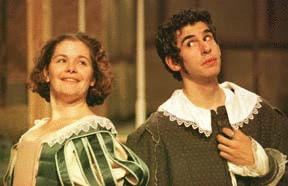Cast and crew of BPA’s “Tartuffe,” opening at the Playhouse Oct. 19, are troupers in the grand old tradition of the theater.
The 24 hardworking amateurs and professionals stepped in to save the day, when “Tartuffe” replaced Larry Shue’s “The Foreigner” as BPA’s season opener in the wake of the terrorist attacks.
“Talking to Joanne (Ellis), talking to the board, we decided a dark theater was just not an option,” director Joanne Keegan said, “Corny as it may sound, we decided that ‘The show must go on.’”
The BPA board decided to pull “Foreigner” when several cast members personally affected by the Sept. 11 attacks left the production.
The play itself touched on sensitive issues, Keegan notes, featuring an explosion off-stage, with plot points that included a box cutter and dynamite.
BPA decided to go forward with Moliere’s “Tartuffe,” which had also been considered for the opening slot.
One drawback to changing shows, however, was that time for rehearsal would be dramatically reduced.
Instead of the standard 11 weeks Keegan had to rehearse “Foreigner,” “Tartuffe” would have to be ready in only a month.
It would take some creative thought to find an appropriate way to stage the production.
Keegan decided to go with a modification of “readers’ theater,” productions in which actors read from scripts.
“Typically in readers’ theater you sit around a table or have a minimal set,” Keegan said, “but for ‘Tartuffe,’ we wanted gorgeous costumes, full sets – the whole nine yards.”
The scripts are carried by each character behind an appropriate item. Elmira carries hers behind a fan, and the maid carries hers behind a feather duster.
“It’s a wink and a nod at the audience,” Keegan said, “and, personally, I think it’s more fun to look at a fan than a script.”
“Tartuffe” is a farcical romp, with a serious subtext.
Moliere exposed religious hypocrisy – and took a not-so-covert swipe at the 17th century Catholic Church – through the misdeeds of the title character.
A self-promoter camouflaged by a pious exterior, Tartuffe has his eye on the estate, wife and daughter of Orgon, his benefactor. Transparent to all but his credulous host, Tartuffe nearly pulls off the nefarious plan.
The play was first performed for French King Louis IV, who gave it good reviews.
Church officials were less charmed, and the work was banned. Moliere was given a list of suggested changes, criteria he tried to meet without eviscerating the text.
The work was again performed – and again banned.
Only on the third try was “Tartuffe” seen by the public.
The fuss over the work still has resonance today; contemporary audiences may recall that a single controversial photograph by Andres Serrano nearly upended the National Endowment for the Arts a decade ago.
And Moliere’s sharp observations on the foibles of human nature are timeless.
A bonus for audiences, resulting from the last-minute change of script, is a chance to see BPA education director Steven Fogell in the title role.
Fogell and Keegan’s professionalism – plus the hard work of many others – has kept BPA’s season on track through the tragedy.
“I can’t believe all the ways everyone’s been affected by Sept. 11,” Keegan said, “but at least we’re providing entertainment.
“And isn’t this just too Broadway? Think of Judy Garland and Mickey Rooney. ‘OK, let’s put on a show. We can do it, kids.’”



